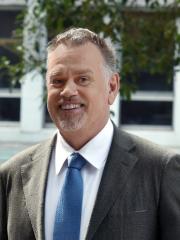
Professor Alan Rowan focuses on the interaction of cells with nanostructured materials and surfaces
A globally recognised leader in bioengineering and nanotechnology, Professor Rowan is renowned for his work at the interface of chemistry, biology, and materials science including the development of the world’s first biomimetic hydrogel that mimics the mechanical properties of human tissue - an innovation that has opened new possibilities in regenerative medicine, wound healing, and drug development.
Professor Rowan’s commitment to research excellence is reflected in his published works, with nearly 400 peer-reviewed publications and a h-index of 83. His work has appeared in leading scientific journals, including 18 publications in Science and Nature family journals, and has been cited almost 26,000 times (Google Scholar). He also holds five patents (with five more pending), and has successfully translated research into real-world applications, co-founding four start-up companies (Encapson, Noviotech, NovioSense and Secmatix) and cultivating numerous collaborations with research institutions and industry partners.
Industry Engagement & Collaborations
Professor Rowan has had the pleasure of supervising more than 55 PhD students who have received their doctoral degree and is particularly passionate about supporting the next generation of scientist-entrepreneurs and setting up Queensland to be an Asian-Pacific leader in medtech.
In addition to his role at AIBN, Professor Rowan is a current ARC Laureate Fellow, a Fellow of the Australian Academy of Science, Chair of the Scientific Advisory Board for the ARC Centre of Excellence in Convergent Bio-Nano Science and Technology, and board member of the UQ Confucius Institute, The Dow Centre for Sustainability, and is the Institute Director representative on UQ’s Senior Executive Team.
Key Publications
Kouwer, P. H. J.; Koepf, M.;..Rowan A. E.; Responsive biomimetic networks from polyisocyano-peptide hydrogels, Nature 493, (7434), 651-655 (2013). This work, described the design, synthesis and properties of the world’s first synthetic semi-flexible polymer network, which mimicked precisely the physical and mechanical properties of extracellular matrices.
Das, R.K.; … Rowan, A. E. Stress-stiffening-mediated stem-cell commitment switch in soft responsive hydrogels, Nature Materials 15, 318–325, (2016). This work is a paradigm shift in stem cell culturing. We demonstrated for the first time that hMSC differentiation is controlled by the stress stiffening mechano-transduction between the cell and the matrix.
Jaspers, M.;… Rowan, A.E.; Kouwer P.H.J. Ultra-Responsive soft matter from stain stiffening hydrogels Nat.Commun., 5, 5808, (2014). The stiffness of hydrogels is crucial for their application. Nature’s hydrogels become stiffer as they are strained. Our experimental work in combination with network theory yields universal laid down the design principles for future strain-stiffening materials.
van Dongen, et al Rowan A.E.; Nolte, R.J. M. A clamp-like biohybrid catalyst for DNA oxidation. Nature Chemistry, 5 (11), 945-951 (2013). This very challenging study was the first biohybrid rotaxane catalyst ever constructed. By modifying the protein bio-machinery found in DNA Nuclease with a porphyrin catalyst, we demonstrated that a functionalized peptide macrocycle could be threaded onto a DNA polymer where upon it could move in a directional fashion along ds-DNA and cleave specific AAA base pairs sequences, mimicking the process of natural DNA exonucleases.
Nagelkerke, A.; …Rowan A.E. The mechanical microenvironment in cancer: how physics affects tumors Semin. Cancer Biol. 35, 62–70, (2015). A review of how the tumour microenvironment contributes greatly to the response of tumour cells.
| Featured projects | Duration |
|---|---|
| Programming Synthetic Dendritic Cells | 2017–2025 |
| Combined confocal-rheology platform for studying ECM-cell interactions | 2017–2025 |
| Wound Management: bioactivation of hydrogel to promote wound healing | 2017–2025 |
